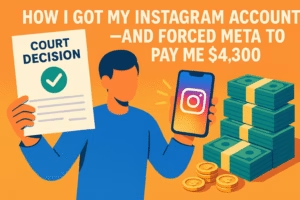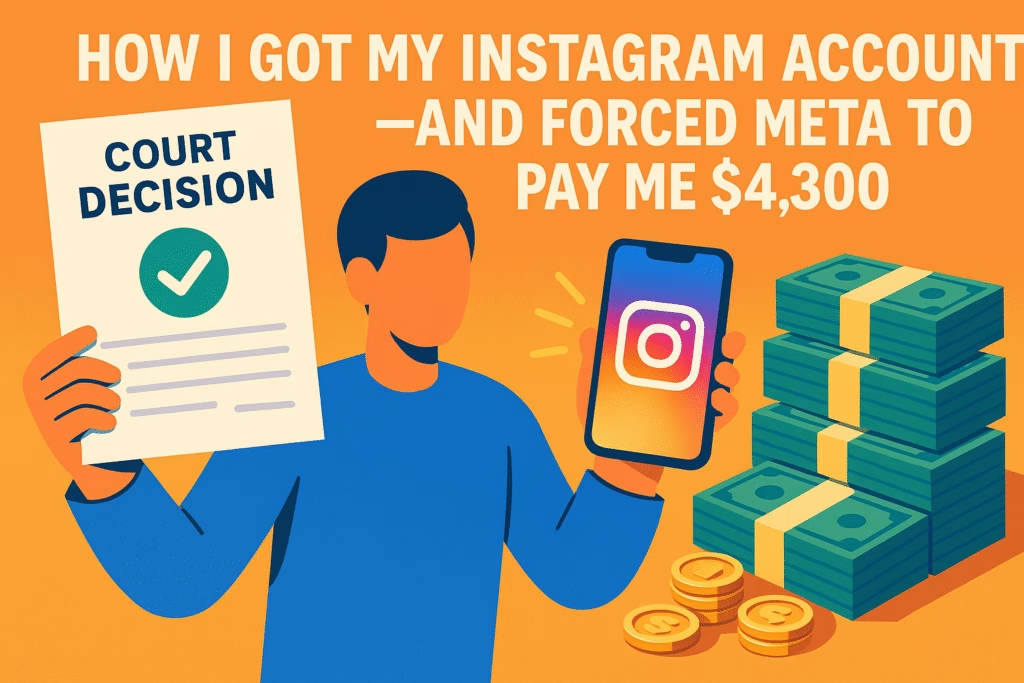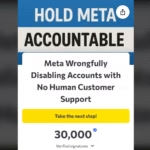They told me the account was gone for good. No reason. No explanation. Just a cold message saying I violated some vague “community guideline.”
I paid for Meta Verified. I was promised priority support, human assistance, and more protection. I got none of it. Instead, I was locked out of years of personal data—university messages, business contacts, even medical records in my DMs.
But I didn’t rant on social media.

I documented everything. I used AI to draft letters. I filed a complaint with my country’s Consumer Arbitration Board. Meta ignored it.
The court didn’t.
Not only did I get my Instagram account back, but the court also ordered Meta to pay me ~$4,300 in damages.
And the best part? I did it without a lawyer.
If you’re fighting to get your account back—this article will show you exactly how I did it, step by step. It works in countries like Turkey, Australia, the UK, and more. Even if you’re in the U.S., I’ll show you what can still be done.
The Short Version (Core Takeaways)
-
✅ You can get your Instagram account back through legal consumer protection channels—especially outside the U.S.
-
🧠 You don’t need a lawyer. I used AI tools (like ChatGPT) to write every letter and document.
-
🕰️ Meta ignored my complaint, and lost in court for it.
-
💰 I won ~$4,300 in compensation from the Consumer Court.
-
🛠️ Tools that helped me post-recovery: MetaHashtags (to rebuild reach)
-
Blaze AI to draft my entire case.
They Banned Me—and Gave Me No Way to Fight Back
I didn’t break any rules. At least, none I was ever shown. My account was Verified with the little blue checkmark. You’d think that meant I mattered more in their system. But when my account was suddenly disabled, Meta gave me nothing:
-
No reason.
-
No explanation.
-
No recovery method.
Just the generic, cold-hearted screen: “Your account has been permanently disabled for violating our Community Guidelines.”
What guidelines? What post? What action?
Crickets.
I tried appealing inside the app. Nothing. I used every recovery form on Meta’s site. No response. Meanwhile, I had urgent messages sitting in my DMs—assignments from students (I’m a university lecturer), medical records from clinics, and work-related contacts that were now lost.
I wasn’t just inconvenienced. I was actively harmed.
And I was paying for this.
I subscribed to Meta Verified. They promised priority support. They promised “increased protection.” They promised someone would help me.
They didn’t even acknowledge me.
That’s when I realized something: If Meta won’t listen to their users, maybe they’ll listen to the law.
The Legal Path: How I Took Meta to the Consumer Court and Won
I didn’t have a lawyer.
I didn’t even leave my house.
But I had documentation. And that was enough.
Here’s exactly what I did:
Step 1: I Filed a Complaint with My Country’s Consumer Arbitration Board
I’m based in Turkey, where we have a powerful consumer protection system called the Tüketici Hakem Heyeti (Consumer Arbitration Committee). Think of it like a small claims court, but streamlined—and free.
I explained everything in my complaint:
- That I had a paid Verified subscription with Meta.
- That they failed to provide services I paid for—like human support, security, and access to critical data.
- That their actions caused emotional, educational, and professional harm (with specifics).
- That this behavior was deceptive, and likely qualified as fraudulent business conduct under consumer law.
The key here: specificity.
Don’t say, “I’m sad.” Say, “My access to medical documents and student assignments was cut off. I suffered academic consequences, and my health was compromised because of it.”
If you can prove real-world harm, the case becomes much stronger.
Step 2: I Let the System Work (While Meta Did Nothing)
Once the committee received my application, they gave Meta’s local representation 15 business days to respond.
Nothing.
Then they granted an additional 15-day extension, assuming international coordination might delay things.
Still nothing.
That was the turning point.
In many countries, failure to respond within a mandated timeframe is seen as an act of bad faith—and in Turkey, it cost Meta.
Step 3: Instagram Suddenly Reinstated My Account
On Day 2 of the extension, like clockwork, I got the notification:
“Your account has been reinstated. We apologize for the inconvenience.”
No explanation. No admission of wrongdoing.
Just a silent backpedal.
But the legal train had already left the station.
How I Got Paid $4,300 in Compensation — Without a Lawyer
Getting my Instagram account back was only the beginning.
I could’ve stopped there and moved on with my life. But Meta had done real damage—and they needed to feel it.
Here’s the part that still surprises people:
The Consumer Arbitration Committee didn’t just force Meta to restore my account. They also ordered them to pay me 128,000 Turkish Lira (about $4,300 USD).
Let’s break down why.
Meta Missed the Deadline — and That Was Enough
The committee had given Meta 15 business days to reply. Even a basic placeholder response would’ve shown intent to cooperate.
They sent nothing.
Under Turkish law (and in many consumer protection frameworks worldwide), silence in a dispute like this isn’t just rude—it’s considered bad faith.
So when they didn’t reply during the original window, the committee ruled that Meta waived its right to defend itself.
And by the time Meta reinstated my account (during the extension), it was already too late.
The damage was done. Legally and emotionally.
How They Calculated the Compensation
Here’s the twist: I never had to justify a dollar amount.
The court looked at the harm based on the documents I submitted:
- I showed that I lost access to important student assignments (as a lecturer).
- I documented missed deadlines, stress, and communications blocked for weeks.
- I submitted screenshots of disrespectful messages I received from Meta’s support team.
All of that added up to reputational harm and psychological stress. And Meta didn’t bother to defend themselves.
That opened the door for the court to impose a significant financial penalty—not just to compensate me, but to punish Meta’s negligence.
The result?
$4,300. No lawyer. All done through my country’s consumer protection channels.
How You Can Use This Strategy in Your Country (Even Without Legal Experience)
This wasn’t just a lucky win. It’s a replicable process—especially if you live outside the U.S. and your country has a halfway-decent consumer protection system.
Let’s go country by country:
🇹🇷 Turkey
Use the Tüketici Hakem Heyeti (THH) – the Consumer Arbitration Committee.
- File a formal complaint online via e-Devlet.
- Attach documentation showing:
- Proof of purchase (Meta Verified subscription)
- Communication history (or lack thereof)
- Specific personal damages
- Use Meta’s Turkish legal entity’s MERSIS number, tax ID, and address in the form.
This system is free, fast, and actually enforces consumer law.
🇦🇺 Australia
You have multiple strong channels:
- ACCC – for subscription fraud or digital services not delivered
- OAIC – for privacy violations or data access refusal
- NSW Fair Trading or your state’s Consumer Affairs body
- Small Claims Tribunals like NCAT, QCAT, VCAT – to demand financial compensation
If Meta operates in your country (and it does in Australia), they must respond to a legally filed consumer complaint. If they don’t, you win by default.
🇬🇧 United Kingdom
Start with:
- Citizens Advice Consumer Service
- ASA – if Verified features were misleading
- ICO – for GDPR and data access violations
- FOS – if you paid and didn’t get services
- Money Claim Online (MCOL) – to sue them in small claims court
All of these are free or low-cost and can result in Meta being legally bound to respond.
🇨🇦 Canada, 🇲🇽 Mexico, 🇻🇳 Vietnam, and others
Look up your country’s consumer authority. For example:
- Mexico – PROFECO
- Vietnam – VCCA
- Canada – Office of Consumer Affairs or provincial agencies
Your main job is to prove damage, not just inconvenience. Show that you were misled by Meta’s promises and hurt in the real world—professionally, emotionally, or medically.
🇺🇸 United States
Here’s where things get tricky.
In the U.S., big tech operates under their own policies. Meta isn’t obligated to respond to most consumer bodies.
But there’s still one powerful path: Small Claims Court.
You’ll need:
- Documentation of your loss (especially if Verified)
- Proof of Meta’s failure to respond
- A clear argument showing damages caused by lack of service
File a claim in your state’s small claims court. Some have online filing options.
⚠️ Pro tip: Mention in your complaint that Meta is actively operating in your state (offices, ad sales, etc.) to establish jurisdiction.
Don’t Know How to Write the Complaint?
I didn’t either—at first.
I used BlazeAI to draft my entire case. I gave it my timeline, screenshots, and facts. It returned a structured, legally sound complaint letter I could file directly.
If you don’t have experience, that’s fine. AI is your legal assistant now. Use it.
What I’d Do Differently to Get My Instagram Account Back (and What You Should Know Before Filing)
Winning against Meta felt empowering. But the road wasn’t smooth.
If I had to do it all over again, I’d avoid these common traps—and I’d be even more strategic from the start.
Let me walk you through it.
1. Don’t Waste Time Begging Meta Support
If your account is disabled, Meta’s “support” is a maze. Even with a Verified badge, I received:
- Zero answers
- Robotic replies
- Dismissive tone (I was told “stop crying” in one email)
The entire Verified program is a smoke screen. You’re paying for the illusion of help. Meta isn’t built to care about individuals.
Lesson? Don’t wait for a savior. Build your case and go legal.
2. Take Screenshots of Everything (Especially Their Silence)
Your strongest weapon isn’t emotion—it’s evidence.
Take screenshots of:
- Subscription receipts
- Account disabled notice
- Failed appeals
- Meta’s lack of response
- Any condescending or dismissive support replies
I attached these as exhibits in my complaint. The court ate it up.
3. Highlight the Real-World Impact (Not Just ‘I Was Sad’)
“I lost my account” means nothing in court.
But when I wrote:
“I am a lecturer. Students had submitted coursework via Instagram DM. I missed deadlines, which harmed their academic progress and my credibility.”
Suddenly, my complaint had weight.
Be specific:
- Missed business deals
- Lost health-related messages
- Emotional distress backed by personal accounts
This isn’t about theatrics. It’s about proving harm beyond inconvenience.
4. Know Who You’re Suing
In most countries, you can’t sue “Meta” in the abstract.
You need:
- Meta’s registered legal representative in your country
- Their business name
- Tax ID or registration number
- Physical address
Google it. Ask ChatGPT. Look on LinkedIn. It matters.
In Turkey, this info made my case valid. Without it, it would’ve been rejected on a technicality.
5. You Only Get One Shot—So Make It Count
The first complaint is everything.
Don’t write a half-hearted rant. Don’t wing it.
Here’s my workflow:
- Write your story in bullet points
- Convert that into a timeline
- Use AI to generate a formal complaint
- Attach all evidence
- Include laws or terms of service they violated
- Submit through your consumer board or small claims process
The more structured and professional you look, the more likely you are to be taken seriously.
Even by the courts.
You Have More Power Than You Think (And You’re Not Alone)
Big Tech counts on your silence.
They assume you’ll scream into the void, click the same broken help links, give up, and start over.
They bank on your exhaustion.
But here’s what they’re not ready for:
You, with a paper trail.
You, with screenshots.
You, with the law on your side.
You, using AI to turn rage into results.
This wasn’t a lucky break. It was the system working—because I made it work. And you can too.
If you’re reading this while staring at a locked account and feeling powerless, know this:
- There’s a path.
- You don’t need a lawyer.
- You don’t need deep pockets.
- You just need the right process and a refusal to stay silent.
The story you just read isn’t the exception. It’s the blueprint.
I didn’t just get my Instagram account back—I got justice.
So can you.
Now go build your case, document everything, and file your complaint.
And if this helped you?
Fuel my fight with coffee → coff.ee/chuckmel
Because the more creators like us speak up, the harder it becomes for Meta to silence us.

